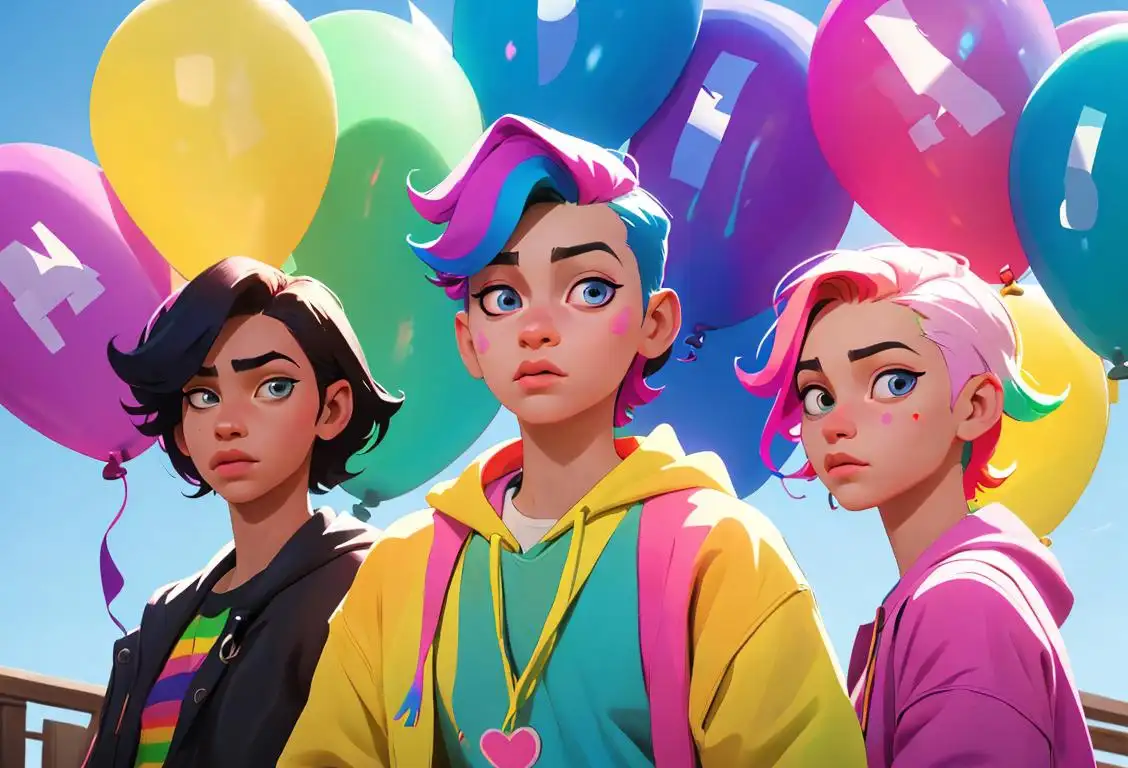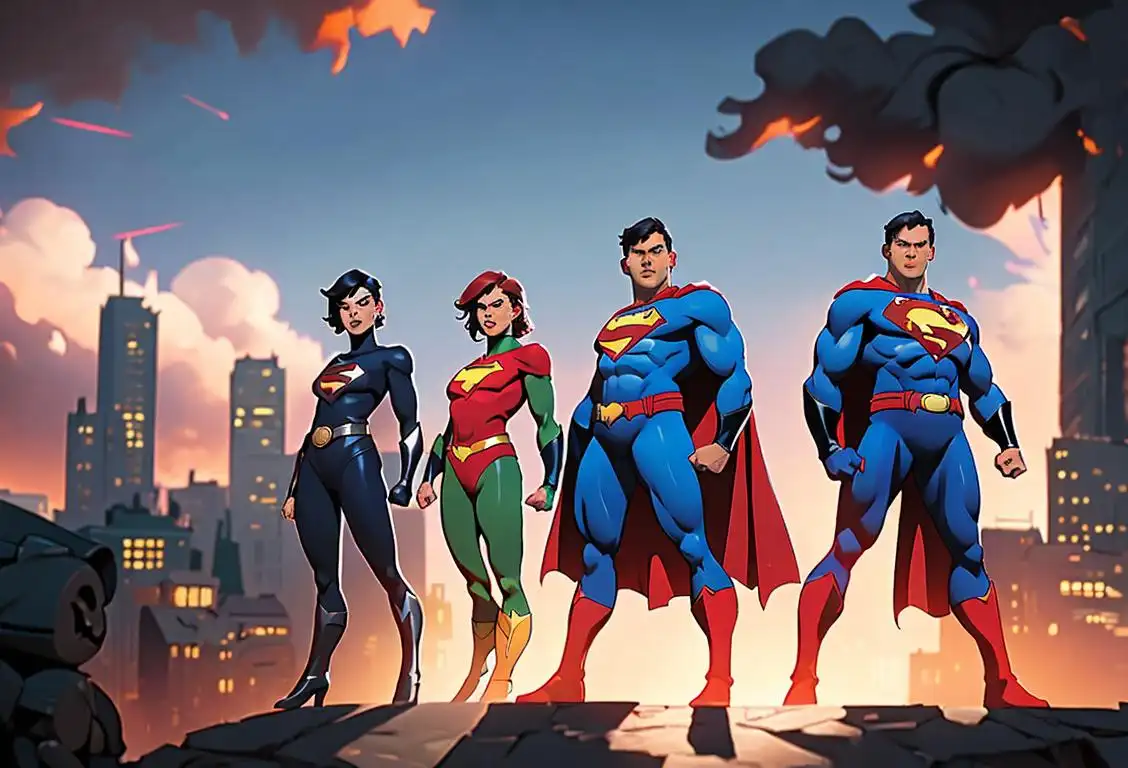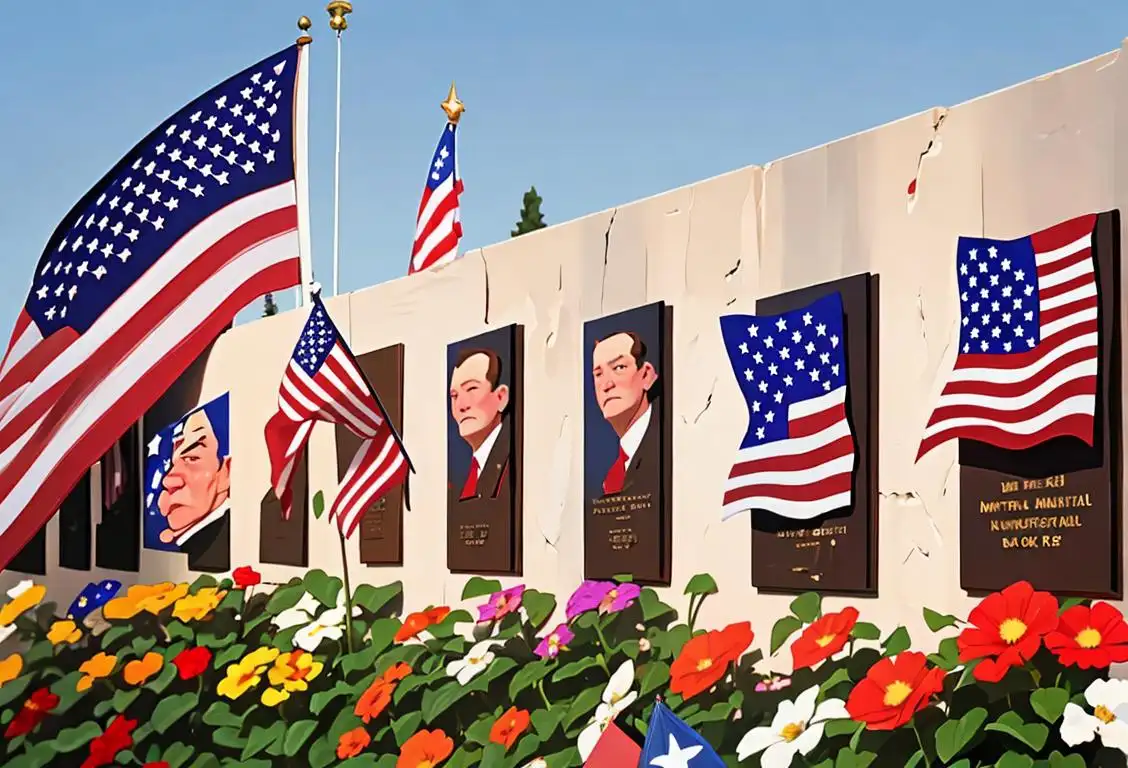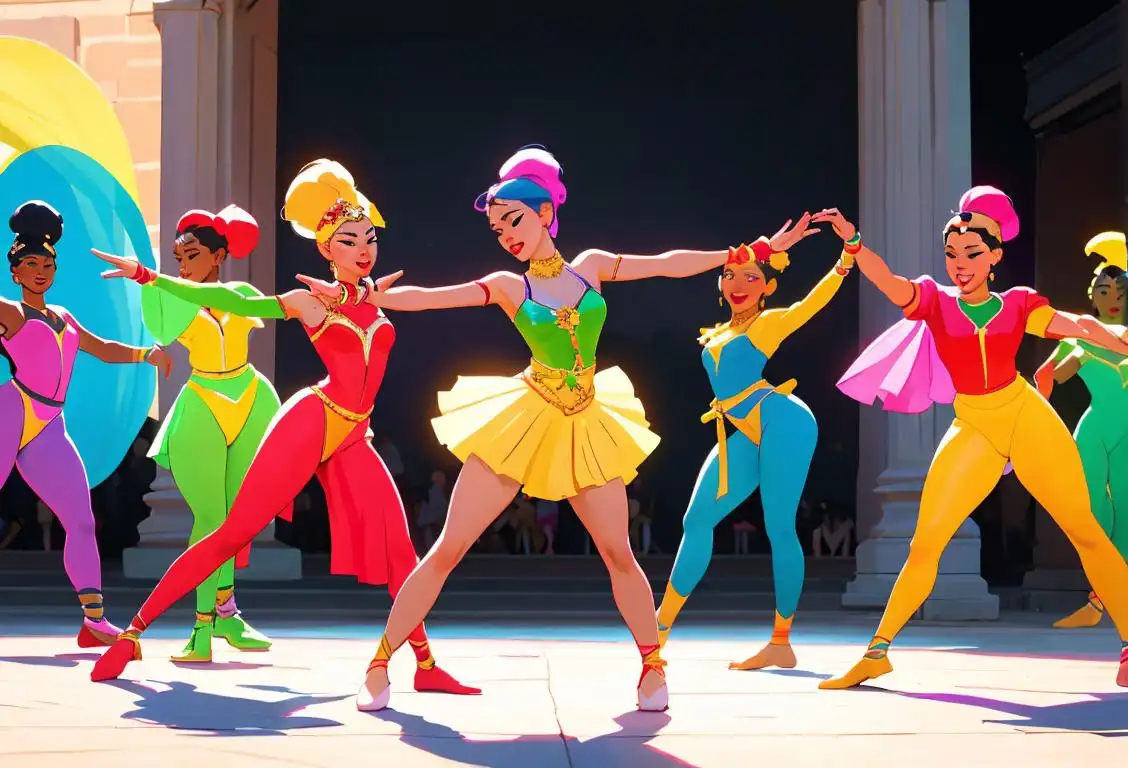National Enby Day

Welcome to National enby Day! Get ready to celebrate and show support for enby individuals across the globe. This special day is all about recognizing and affirming non-binary people, who identify outside of the traditional gender binary. So, let's dive into the fascinating history of National enby Day and explore the significance behind it.
When is Enby Day?
It's national enby day on the 14th July.
The Birth of National enby Day
Back in the vast expanse of the internet, there was a collective need to celebrate and uplift non-binary individuals who proudly and courageously express their gender identity. And thus, National enby Day came into being, like a phoenix rising from the ashes of outdated gender norms.
Though the precise origins remain shrouded in mystery, one thing is clear - the love and appreciation for non-binary individuals sparked the creation of this joyous occasion. It serves as a reminder that gender is a spectrum, and every identity within it deserves recognition and respect.
How to Celebrate National enby Day
On National enby Day, it's all about embracing diversity and empowering enby folks. Here are a few ways you can celebrate:
- Education and Awareness: Take the time to learn more about non-binary identities and the challenges they face. Spread knowledge and understanding among your loved ones.
- Advocacy: Support organizations that work tirelessly to protect the rights of non-binary people. Raise your voice and help create a more inclusive society for all.
- Show Love: Reach out to the non-binary individuals in your life and let them know you appreciate and cherish them. Sometimes, a simple act of kindness can make a world of difference.
Fun Fact
Did you know that National enby Day coincides with International Non-Binary People's Day? So, while celebrating National enby Day, you're also joining a global celebration of non-binary individuals. It's a double dose of love and acceptance!
History behind the term 'Enby'
1990
Coined term 'nonbinary'
In the year 1990, the term 'nonbinary' was coined to describe individuals whose gender identity does not strictly align with the traditional binary categories of male or female. This term recognized the existence and validity of gender identities beyond the limited binary framework.
2015
Emergence of Non-Binary Terminology
In the year 2015, the term 'enby' emerged as a popular term within the non-binary community. 'Enby' is a phonetic abbreviation of the letters 'NB,' which stands for 'non-binary.' Non-binary is a gender identity that does not fit within the traditional binary categories of male and female. The term 'enby' quickly gained popularity as a self-identifier among individuals who identify as non-binary or genderqueer.
2014
Origin of the term 'enby'
In 2014, the term 'enby' emerged as a gender-neutral alternative to the terms 'boy' or 'girl'. It is derived from the pronunciation of the abbreviation 'NB,' which stands for non-binary. The term 'enby' quickly gained popularity within the LGBTQ+ community as a way to affirm and validate individuals who do not identify strictly as male or female.
2014
Introduction of the term 'enby'
In 2014, the term 'enby' emerged as a gender identity term, serving as an abbreviation for 'nonbinary.' It was created as a more concise alternative to the term 'nonbinary,' which refers to individuals who do not exclusively identify as male or female. The term 'enby' gained popularity within the online nonbinary and genderqueer communities.
1995
Origins of the term 'enby'
The term 'enby' originated from the abbreviation of the word 'non-binary.' It was first used in the online community in 1995 and gained popularity as a shorthand term to refer to individuals who do not identify exclusively as male or female.
1965
Nonbinary conception
The term 'enby' has its roots in the nonbinary gender identity movement, which emerged alongside the feminist and LGBT movements in the mid-20th century. While the term 'nonbinary' started gaining popularity in the 1990s, the concept of identifying outside the traditional gender binary has a much longer history. In 1965, the term 'genderqueer' was coined to describe individuals who did not identify as exclusively male or female.
1990
Origins of non-binary gender identity
The term 'non-binary' emerges as a breakaway from the gender binary, which recognizes only two genders: male and female. Non-binary refers to individuals whose gender identity doesn't exclusively align with either of these categories. This term gained prominence among academics and activists who sought to validate gender diversity and provide visibility to those who identified outside the traditional norms.
2014
Emergence of the term
In 2014, the term 'enby' emerged as a short form of the word 'nonbinary.' Nonbinary, in the context of gender identity, refers to individuals who do not exclusively identify as either male or female. 'Enby' was coined as a more inclusive and affirming alternative to the term 'nonbinary,' offering a less binary and more neutral way to describe one's gender identity.
2013
Emergence of the term 'enby'
In 2013, the term 'enby' came into prominence within the non-binary and genderqueer community as a short form of the word 'NB' (non-binary). It was coined as an alternative to traditional gender labels such as 'man' or 'woman', providing a gender-neutral option for individuals who do not identify strictly as male or female.
2006
Introduction of 'enby' as an abbreviation
Around the year 2006, the abbreviation 'enby' started to gain popularity as a shorthand for 'NB,' which stands for nonbinary. 'Enby' is phonetically derived from the letters 'NB' and is often used as a noun to refer to nonbinary individuals.
2014
Introducing the term 'enby'
'Enby' was coined as a shortened form of 'non-binary' and gained traction in online communities. It offered a more inclusive and gender-neutral alternative to the longer term. 'Enby' quickly became popular among non-binary individuals to self-identify and connect with others who shared their experiences, creating a sense of community and belonging.
2019
Usage in Online Communities
By 2019, 'enby' had become widely used in online communities, mainly on social media platforms like Twitter and Tumblr. It provided individuals with a concise and inclusive way to describe their gender identity. The term allows non-binary individuals to assert their identities without conforming to the language and labels of the gender binary.
2005
Emergence of 'NB'
As the internet became more accessible and social media platforms started to thrive, a need arose for shorter and more inclusive terms to describe nonbinary individuals. In 2005, the abbreviation 'NB' was popularized as a convenient way to refer to 'nonbinary' within online communities. This abbreviation later served as a precursor to the term 'enby'.
2014
Enby reaches online forums
By 2014, the term 'enby' had gained traction and started being used more widely on online platforms such as social media and forums dedicated to gender identity discussions. People began adopting the term to proudly identify themselves as non-binary and to create a sense of community and belonging among others who shared similar experiences.
2015
Usage in online communities
By 2015, 'enby' had found its way into various online communities, particularly on social media platforms and forums. The term became widely adopted as a self-identification for individuals who align with the non-binary gender identity. Its usage helped foster a sense of community and support among non-binary individuals, allowing them to express their identity and connect with others who shared similar experiences.
2015
Usage expands on social media
During 2015, 'enby' continued to grow in usage and visibility on social media platforms such as Tumblr and Twitter. Nonbinary individuals embraced the term as a way to easily identify themselves and connect with others who shared similar experiences. The term 'enby' became a positive and affirming way for individuals to express their gender identity.
2014
Development of online communities
As the term 'enby' gained popularity, it quickly found a home within online communities that focused on gender identity and expression. These communities, including forums, social media platforms, and online support groups, provided a safe space for individuals to discuss and explore their nonbinary identities. 'Enby' became widely used as a term of self-identification and solidarity within these communities.
2012
Rise of gender identity discussions
In 2012, the conversations around gender identity started gaining significant visibility. This led to an increased need for inclusive language that acknowledged individuals who identified beyond the traditional gender binary. The term 'enby' started gaining traction during this time as a way to affirm and empower those who identified as non-binary.
2015
Broadening awareness and acceptance
As more non-binary individuals embraced the term 'enby,' it began to spread beyond online spaces and into offline conversations. Activists and advocates used the term in educational campaigns to raise awareness about gender diversity and challenge societal assumptions surrounding gender identity. This helped foster acceptance and understanding among a broader audience.
2015
Inclusion in language
The term 'enby' started to make its way into mainstream conversations and was increasingly used as an inclusive and gender-affirming language. It provided a concise and accessible way for people of all genders to respect and acknowledge nonbinary individuals. By using 'enby,' people could refer to someone without presuming or relying on traditional gender categories.
2016
Inclusion in gender-inclusive language
By 2016, 'enby' had made significant strides in improving gender-inclusive language. Its adoption helped challenge the binary notion of gender, promoting more inclusive and diverse discussions. As society began to recognize and acknowledge the existence of nonbinary people, the term 'enby' played a role in fostering acceptance and understanding.
2012
Enby enters the scene
In the early 2010s, the term 'enby' emerged as a unique and inclusive alternative to 'NB'. The term 'enby' is a phonetic variant of the abbreviation 'NB', and it intentionally avoids the use of letters that resemble gender-specific pronouns. Its adoption gained traction within online forums, social media, and LGBT+ communities as a way to embrace and celebrate nonbinary identities in a linguistically creative manner.
2020
Mainstream Recognition and Inclusion
In 2020, 'enby' started to gain increased recognition and usage in mainstream media and LGBTQ+ spaces. The term became an important part of discussions surrounding gender diversity and inclusivity. Its usage helped raise awareness and understanding of non-binary identities, challenging and expanding the traditional binary view of gender.
2015
Enby enters mainstream consciousness
In 2015, 'enby' started to enter mainstream consciousness as a legitimate term to describe individuals who identify outside the gender binary. It began appearing in articles, blog posts, and even in some official documents as a recognized gender identity option. This increased visibility helped to raise awareness about non-binary identities and promote inclusivity.
2014
Usage of 'enby' in online communities
In 2014, the term 'enby' began to be more widely used within online communities, particularly within LGBTQ+ spaces and discussions. Its use allowed for a more concise and inclusive way to refer to nonbinary individuals, reflecting the growing recognition and acceptance of diverse gender identities.
2014
Widespread usage on social media
By 2014, 'enby' had become widely used on social media platforms, particularly within LGBTQ+ communities. The term provided a sense of community and belonging for non-binary individuals, fostering a supportive environment for discussion and representation.
2018
Inclusion in dictionaries
The term 'enby' gained significant recognition in 2018 when it was added to certain dictionaries. This inclusion marked a crucial moment in the recognition of non-binary identities and demonstrated a growing acceptance of non-binary language. Seeing the term 'enby' in reputable dictionaries helped raise awareness and understanding of non-binary gender identity and further contributed to its validation within mainstream society.
2016
Recognition in mainstream culture
In 2016, the term 'enby' started to gain recognition in mainstream culture. It began appearing in online publications, books, and various forms of media, opening up conversations about gender identity and challenging societal norms.
2019
Recognition by dictionaries
In 2019, the term 'enby' achieved recognition by major dictionaries, solidifying its place in the English lexicon. Dictionaries, such as Merriam-Webster and Oxford English Dictionary, added 'enby' to their official collections, recognizing its cultural significance and usage. This acknowledgment further legitimized and affirmed the experiences of nonbinary individuals.
2021
Inclusion in Official Dictionaries
As of 2021, 'enby' has gained enough recognition and usage to be included in some official dictionaries. Its inclusion signifies the growing acceptance and acknowledgment of non-binary identities in society. By adding 'enby' to dictionaries, it becomes more accessible and validate the experiences of non-binary individuals.
2015
Inclusion of 'enby' in official dictionaries
By 2015, 'enby' had gained enough recognition and usage to be included in some official dictionaries and reference sources. This inclusion marked a significant step in validating the term and acknowledging its cultural relevance. It provided further visibility and accessibility for the term 'enby' as an accepted nonbinary identity descriptor.
2016
Enby gains recognition in dictionaries
By 2016, the term 'enby' had gained enough popularity and recognition to be included in some online dictionaries, such as Merriam-Webster and Oxford Dictionaries. This further solidified its legitimacy as a gender identity term and helped to educate a broader audience about non-binary experiences.
2018
'Enby' enters mainstream usage
The term 'enby' made its way into mainstream culture, appearing in media and popular discourse. Its usage was not only limited to non-binary communities but also extended to cisgender individuals who embraced the term as a way to signal their support for gender inclusivity and challenge restrictive gender norms.
2015
Inclusion in mainstream discourse
By 2015, the term 'enby' had reached a level of visibility and recognition that allowed it to be included in the broader conversation surrounding gender identity. As nonbinary issues gained more attention in the media and society at large, the term 'enby' became increasingly utilized as a gender-neutral descriptor for individuals who identified outside the male/female binary. 'Enby' helped to create a sense of community and empowerment among nonbinary individuals.
2017
Enby enters mainstream consciousness
In 2017, 'enby' gained further recognition and visibility in mainstream media. Journalists, writers, and educators started using the term in their work to educate others about nonbinary experiences and identities. More people outside of the nonbinary community became aware of the term 'enby' and its cultural significance in advocating for gender diversity and inclusivity.
2020
Widespread recognition
In more recent years, the term 'enby' has gained widespread recognition, not only within LGBTQ+ communities but also among the general public. Its usage has expanded beyond online spaces, making its way into discussions, media, and even some official documents. 'Enby' has become an emblem of non-binary identity, representing a gender-inclusive language that promotes visibility and inclusivity for those who do not conform to traditional gender norms.
2017
Enby becomes part of LGBTQ+ discourse
In 2017, 'enby' became a significant part of the LGBTQ+ discourse, with organizations, activists, and community leaders using the term in their advocacy work and discussions around gender diversity. Its usage within the larger LGBTQ+ community helped to foster acceptance and understanding of non-binary identities and encouraged people to challenge traditional gender norms.
Present
Continued usage and representation
Today, the term 'enby' continues to be used as a positive and affirming way to refer to nonbinary individuals. It has become an integral part of LGBTQ+ vocabulary and has been embraced by many nonbinary individuals as a self-identifying term. 'Enby' symbolizes the ongoing progress in recognizing and respecting the diverse and fluid nature of gender identities.
2020
Enby's presence in popular culture
As of 2020, 'enby' has extended its presence into popular culture. It can be found in books, TV shows, and movies, further contributing to the normalization of nonbinary identities. The term 'enby' serves as a beacon of validation and pride for those who identify as nonbinary, illustrating the progress made in recognizing gender diversity and providing a sense of community.
2021
Continued growth and acceptance
As of 2021, the term 'enby' has continued to gain acceptance and visibility. It is recognized as an inclusive and affirming term for individuals who identify as non-binary. 'Enby' has played a crucial role in raising awareness about non-binary experiences, fostering understanding, and promoting inclusivity within society.
Present
Continued use and advocacy
Today, 'enby' continues to be widely embraced and used by nonbinary individuals and their allies. It has become an important tool for fostering inclusivity, challenging gender norms, and promoting acceptance. The term exemplifies the ongoing evolution of language and the recognition of diverse gender identities, reminding us of the importance of intersectional understanding and acceptance in our society.
2020
Enby in popular culture
As of 2020, the term 'enby' has made its way into popular culture, appearing in books, movies, and TV shows. It has become a symbol of gender inclusivity and empowerment, representing the voices and experiences of non-binary individuals. 'Enby' continues to evolve, adapt, and empower people to embrace their authentic selves while challenging societal norms surrounding gender.
Did you know?
Did you know that National enby Day coincides with International Non-Binary People's Day? So, while celebrating National enby Day, you're also joining a global celebration of non-binary individuals. It's a double dose of love and acceptance!Tagged
awareness funFirst identified
14th July 2020Most mentioned on
14th July 2020Total mentions
53Other days
Nurses Day
Former Prisoner Of War Recognition Day
Press Day
Handloom Day
Heroes Day
Memorial Day
Dance Day
Bestfriends Day
Liberation Day
Love Your Pet Day









